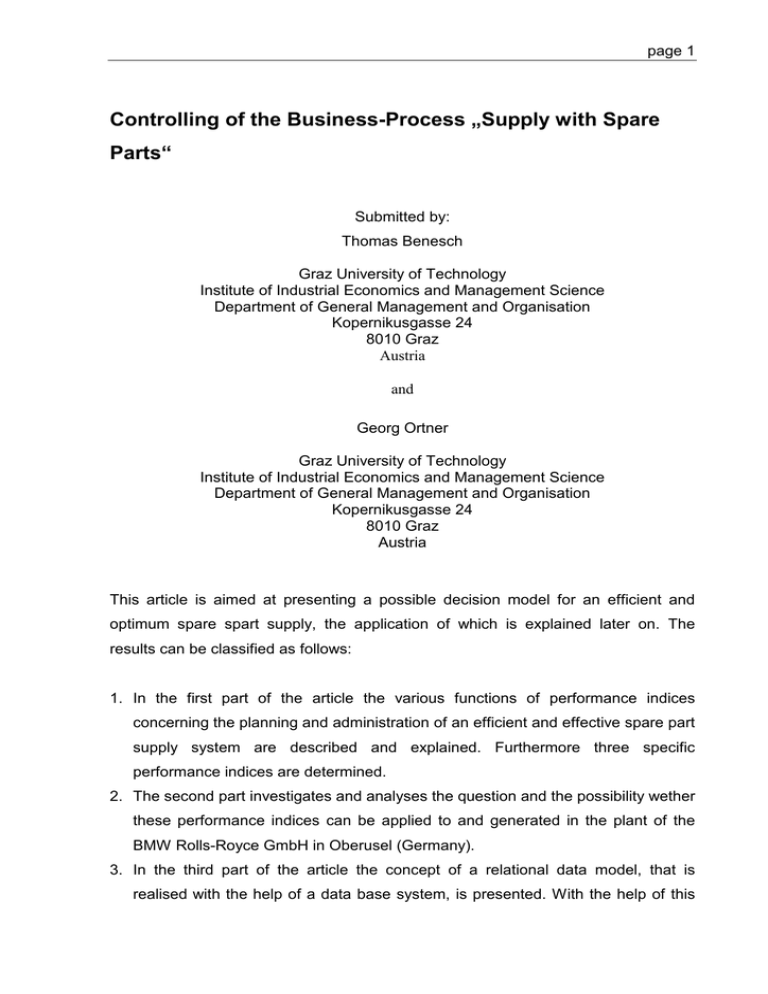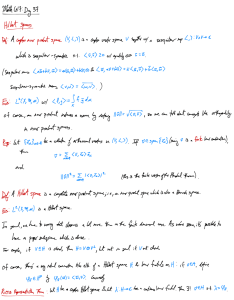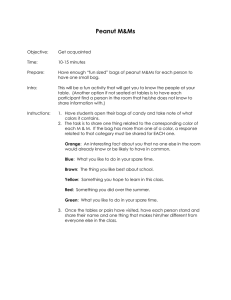Controlling of the Business-Process „Supply with Spare Parts“
advertisement

page 1 Controlling of the Business-Process „Supply with Spare Parts“ Submitted by: Thomas Benesch Graz University of Technology Institute of Industrial Economics and Management Science Department of General Management and Organisation Kopernikusgasse 24 8010 Graz Austria and Georg Ortner Graz University of Technology Institute of Industrial Economics and Management Science Department of General Management and Organisation Kopernikusgasse 24 8010 Graz Austria This article is aimed at presenting a possible decision model for an efficient and optimum spare spart supply, the application of which is explained later on. The results can be classified as follows: 1. In the first part of the article the various functions of performance indices concerning the planning and administration of an efficient and effective spare part supply system are described and explained. Furthermore three specific performance indices are determined. 2. The second part investigates and analyses the question and the possibility wether these performance indices can be applied to and generated in the plant of the BMW Rolls-Royce GmbH in Oberusel (Germany). 3. In the third part of the article the concept of a relational data model, that is realised with the help of a data base system, is presented. With the help of this page 2 data model a computer-based data processing which itself is essential for the evaluation and determination of the above mentioned performance indices, as well as a non-redundant aquisition of the data required is made possible. Ad 1. Performance indices in the business process „supply with spare parts“ The business process „controlling“ includes the processes „goal setting“, „planning“ and „monitoring“ concerning the productive capacity of a plant. An essential controlling and monitoring instrument in this process are performance indices with the help of which main company goals as well as various sub-goals can be quantified, developments (in-plant and inter-plant) can be observed, economic analysis of various business processes can be carried through and deviations from defined goals can be measured. The primary goal in the field of the spare part supply is the minimisation of the total costs. These total costs come up if you add all the costs resulting from storing and purchasing spare parts as well as from possible machine down-times while waiting for the respective spare part. When making decisions concerning the spare parts supply, one has to take into account that the goal aimed at minimising just one single type of these many various costs can in fact lead to an immense increase of the total costs. In order to avoid this negative development two performance indices have been determined as a decision support in the field of the spare part supply: • decisive-relevant costs of the spare part supply (in german: Entscheidungsrelevante Kosten der Ersatzteilversorgung = EKEV): these result from the sum of the above mentioned various cost types. With the help of this performance index the achievement of the primary goal in the spare part supply process can be controlled and monitored. This way decisions the consequence of which are a minimisation of these EKEV, can be avoided. • the 2nd performance index is necessary in order to quantify a possible unutilised potential of the chosen form of spare part supply. To this end the difference between the actual EKEV and those EKEV that would have occured in case of a variation of the parameters „purchasing time“ and „order quantity“ is determined. Variants can be the supply-related parameters „optimum order size“ („AndlerFormel“) or „risk inventory“ (stock of 1 or 2 spare parts). If it is possible to predict the future behaviour of the determining factors of the EKEV, page 3 especially the future demand for spare parts, these performance indices can act as a support in making the decision, which and how many spare parts should be held in stock. With the help of the model presented here the desicion whether it is economically seen more convenient to keep spare parts in stock or to order the respective part at the supplier not until a possible failure should become much more easier. To this end however, it is of great importance to combine various components of the different special fields and to look at them as a whole, a fact that has not been taken into 1 account in the past, especially in literature . The results presented here have been developed through an interdisciplinary combination and practical application as well as logical interpretation of already existing findings in the fields controlling, general materials management and control, spare part management and control and process-oriented business management and business planning. 1. Introduction The concept of organising and planning lean and powerful business structures and companies requires certain qualifications, one of which, for example is that the performance of all business processes in a company are transparent and can be controlled at any time. An important and essential instrument to achieve this goal is therefore the establishment of an efficient and logically arranged system of performance indices which is aimed at the quantification of specified objectives and subgoals of a company or business corporation. The knowledge of these performance indices allows the finding of possible deviations from defined goals, the determination and analysis of critical points and potential trouble spots as well as their cause and in the end a performance evaluation of taken measures. Due to its complexity and versatility, the process of the spare part supply makes high demands on the system of performance indices. Only by looking at the data collected in the various fields and subdomains like purchasing, inventory management and control, maintenance and production as a whole, it becomes somehow possible to generate not all but at least some essential performance indices. In this context, the 1 Compare all Books, which where the result of a search (at the 20.03.1999) in the catalogue of the german library in Frankfurt am Main, using the catchword „Ersatzteil*“. page 4 minimisation of capital tie-up within the non-productive sections that is linked with the spare part supply plays an important and significant role because it is this minimisation which is in strong contradiction to the philosophy of lean production.2 It is therefor not a goal of the spare part supply to avoid a down time at all costs by keeping masses of spare parts in stock but to minimise the total cost of the spare part supply through an efficient business-specified optimisation of the relationship between down time costs and ordering and inventory holding costs. In this article two performance indices are presented which should help to achieve this goal. The article is constructed as follows: 2. controlling in the spare part supply 3. goal system of the spare part supply 4. performance indices of the spare part supply 5. summary and conclusions 2 see SCHÖNSLEBEN (98), p. 65f page 5 2. Controlling in the Spare Part Supply Each single company in the free market is under the influence of various tensions. These tensions are in turn themselves influenced by a number of various factors which are called determinants of competition (see PORTER3). A situational analysis of these variables represents the basis for the formulation of a business specified goal system. Proceeding from these defined corporate goal systems, functional subgoals can be derived from the very same as well, see Illustration 1. The basic principle of a goal system is, as we can see, that all those subgoals as well as action-relevant information have the sole purpose to achieve the superior parent goals. threat of substitute products bargaining power of customers bargaining power of suppliers rivalry among existing competitors corporate strategy (goals) controlling threat of new entrants production (goals) sales (goals) and so on controlling (segment production) maintenance Contr. (goals) material management (goals) (Segment Produktion) and so on controlling (segment maintenance) supply with spare parts (goals) maintenance strategy (goals) and so on Illustration 1: Connection between the determinants of competition and the formulation of targets 3 4 4 see PORTER (88), p. 26 based on GAMWEGER (98), p. 102 page 6 According to SCHRÖDER5 controlling represents the modern concept for business management and control, which includes the components planning, analysis and control and which can only take control over functions when based on an information system that meets all necessary requirements and demands. The business-specified goals shown in Illustration 1 represent the basis for the controlling cycle (see Illustration 2). Based on these goals follows the planning concept and its tightness which determines time and progress regarding the achievement of goals. The next step is an analysis of the current situation and the examination of possible deviations from these goals. Authorities and the management, for example the maintenance management, have to be informed about the results immediately because these represent the basis for eventual corrective measures. These measures in turn are aimed at minimising possible deviations from defines objectives.6 1 set targets 2 determine planning value 6 plan measures 5 report results 3 analyse current situation 4 examinate deviations Illustration 2: Controlling-cycle7 5 6 7 see SCHRÖDER (92): p.21 see GAMWEGER (98): p. 102 f source: GAMWEGER (98): p. 103 page 7 Tasks and global goal systems of the processes in the spare part supply An important and essential task of the business sector spare part supply is to guarantee the provision of those spare parts which are designed to meet the special requirements and which are necessary for the maintenance of plant and machinery, in the required amount, at the respective supplier and available at any time.8 The tasks of the spare part supply-sector include the planning and controlling of the various processes of the supply with spare parts, especially the ordering and purchase as well as the storage of spare parts. The supply can be realised with the help of „planned“ and „unplanned“ processes of the spare part supply. The process of the unplanned ordering and purchase of spare parts starts after the respective part has failed. The process of the planned ordering and purchase of spare parts starts even before the respective part has failed. Normally it is necessary to keep this ordered spare part in stock. With the help of the sub-process provision of spare parts the part can be provided in case of failure to the maintenance.9 planned supply with spare parts Planned ordering and • the part to be replaced has not failed so far purchase of spare parts • the spare part is obtained from a supplier Provision of spare parts • the part to be replaced has already failed • the spare part is obtained from the stock unplanned supply with spare parts Unplanned ordering • the part to be replaced has already failed and purchase of spare • the spare part is obtained from a supplier parts Illustration 3: Time sequence and spare parts sources of spare parts supply processes10 8 see BIEDERMANN (95), p. 5 own definition based on the definition of the planned and unplanned maintenance (see JACOBI (92), S 17) 10 source: own illustration 9 page 8 Illustration 3 shows a time sequence regarding the moment of the failure of the respective part as well as the various sources of the spare part supply during the various processes. Illustration 4 shows the planned and unplanned spare part supply in a block diagram. unplanned spare part supply maintenance unplanned ordering and purchase unplanned supply with spare p.* planned spare part supply maintenance planned ordering and purchase store provision planned supply with spare parts Illustration 4: Unplanned and planned supply with spare parts11 *=parts 11 source: own illustration page 9 3. Goal System of the Spare Part Supply The primary goal in the spare part supply consists in the minimisation of the total costs of • interruption of production and production cutback due to time loss while waiting for ordered spare parts • storing of spare parts • ordering and purchasing respective spare parts Due to the fact that the above mentioned types of costs sometimes have a complementary character, an isolated minimisation of just one separate sector can lead to a suboptimization which - by closer inspection of the total costs - can in turn lead to negative economic consequences. This conflict of goals becomes apparent when we observe on the relationship between these goals of different levels and sections and possible measures in order to achieve these goals, see illustration 5. In case of a breakdown it can for example - economically seen - in one specific case seem more convenient to waive an expensive express delivery in favour of a much cheaper train delivery. Here we can on the one hand observe cost savings concerning the purchase of the respective spare part but on the other hand we are also confronted with an immense increase in the down time costs due to an extended delivery time. These down time costs are most of the time much higher than the delivery costs. In order to avoid such a suboptimum it is of high importance that the total costs are to be taken into consideration during the planning process as well as during the controlling. page 10 reduction of the total costs reduction of costs caused by production cutback increased uunplanned ordering and purchasing reduction of costs caused by storaging or reduction of costs caused by ordering and purchasing store at the own company reduction of costs for transport reduction of the time and reduction of time for transfor transport (supplier port (arrival at the own comarival at the own company) pany-division maintenance) delivery with special messenger or delivery with air-mail delivery with train Illustration 5: Example for the target-hierarchy of the supply with spare parts12 4. Performance indices of the Spare Part Supply With the help of performance indices it is possible to determine essential facts, possible changes of the same as well as problems like, for example, unused potential and unutilised capacity within a company in a quantified way. By using these performance indices the following tasks can be realised and performed.13 • control of the sequence of operation/in-plant flow of operation in order to avoid deviations from defined goals and to protect the achievement of these goals • provision of an instrument for analysis in order to find possible critical points and potential trouble spots as well as their cause and effects. 12 13 source: own illustration, based on HABERFELLNER (94), p. 141 GAMWEGER (98), p. 108 page 11 Minimisation of costs In order to avoid that essential cost components are not taken into consideration during the controlling process of the spare part supply, those costs which are caused by production cutback due to time loss while waiting for the respective spare part are added to the total costs of the supply with spare parts as well. This way we get the so-called decision-relevant costs of the spare part supply (in german: Entscheidungsrelevante Kosten der Ersatzteilversorgung = EKEV). In illustration 6 the essential costs components of the EKEV are shown. cost price + internal costs of ordering and purch. costs of ordering and purchasing spare parts costs for bound capital + costs for storage + costs of storaging spare parts = costs of the spare parts economy time of production cutback [min] + costs of production cutback caused by waiting for spare parts = decision-relevant costs of sparepart supply (EKEV) * monetary assessment [DM/min] target Illustration 6: Essential cost-components of the EKEV MINIMIZE 14 Informative value of the EKEV The goal of the spare part supply is the minimisation of the total amount of the EKEV. Due to the fact that the EKEV are an absolute performance index, they only have informative value in that case that they are visualised in form of a diagram in chronological sequence or that they are compared to other variations of the spare 14 source: own illustration page 12 part supply. In case of a comparison of companies this process is called benchmarking.15 Cost saving potentials in the spare part supply As an alternative to the above mentioned benchmarking, benchmark figures can be evaluated by the variation of the parameters „when“ and „how much“ spare parts shall be purchased. To this end we could use for example, the optimum order quantity (Andler-Formel). The sum of the costs (see Illustration 6), which, which a possible alternative supply with spare parts in a period of time in the past would have caused is called EKEVAlternativ. The difference between the EKEVAlternativ and those EKEV variables that have actually been determined in that period of time, represents the performance index potential of the decision relevant costs of the spare part supply (in german: Potential der entscheidungsrelevanten Kosten der Ersatzteilversorgung = PEKEV). The PEKEV can be calculated as follows: PEKEV [DM] = EKEVAlternativ [DM] – EKEV [DM] This new performance index quantifies a possible and in the past unused and unutilised potential of cost savings. 16 Use of performance indices The above mentioned performance indices can be used for the realisation of the controlling cycle. When these performance indices are being used in order to define a planning concept and its tightness or to undertake possible corrective measures, it is very important to take into consideration, if the cost behaviour of the past can be applied on future planning as well. 15 16 see GAMWEGER (98), p. 108 based on GAMWEGER (98), p. 108 page 13 Here one has to take into account the possibility that the demand for spare parts as well as their price might change.17 If it is assumed that the cost behaviour will not change and is identical to the current one, one can expect an immense cost saving through an alternative supply with those items the PEKEV of which (with a negative algebraic sign of course) are of the lowest value. These performance indices can be visualised and edited in lists, reports and diagrams (e.g. ABC analysis18) and are this way available for authorities. Additional performance indices In order to cope with those problems that are subordinated in the hierarchy goal system (e.g. the adjustment and correction of the inventory), they can be complemented by already existing performance indices of the material management and control (for example the service degree19). 5. Summary and Conclusions The implementation of an instrument for an exact measuring of time and costs variables is necessary for an effective and efficient planning and organising of the spare part supply. The performance indices presented here take into account equally all types of costs that come up in the spare part supply and are aimed at achieving the overall objectives. If these performance indices are used as a decision support, it can be avoided that various subgoals - instead of the primary goal - are achieved. The performance indices also represent a decisional base in order to answer the question whether the supply with spare parts should be a planned or a unplanned one. Future research and development We can observe not only a demand but indeed a need for further research and development especially as far as the combination and extension of already existing 17 18 see HECK, K. (92), p. 712 see OELDORF (98), p. 123 page 14 performance indices as well as the development of a clearly arranged performance index system are concerned. To this end, one task could be, for example, to combine the performance indices of the business process „spare part supply“ with those of the „maintenance“ and „production“20. Furthermore, one should also be aware of the fact that the informative value of these performance indices and their practical usefulness has not been measured or analysed in detail so far. In this context, many questions have remained unanswered and the sole purpose and task of this article on hand was to offer some ideas and suggestions as well as possible strategies. In the end it has become clear, however, that a precise examination and investigation of the optimisation process in the field „spare part supply“ requires a complex approach where various different points of views have to be taken into consideration. This fact has been taken into account in this article on hand by interdisciplinary combining the various findings in the fields „controlling“, spare parts management & control“, „process-oriented business management and business planning“ and „materials management & control“. This way a wide spread concept was drawn up and realised. 19 20 see REFA-Verband für Arbeitsstudien (91), p. 124 see BIEDERMANN (92), p. 775 page 15 Bibliography 1) BIEDERMANN, Hubert: Ersatzteil-Logistik, VDI Verlag, Düsseldorf 1995 2) BIEDERMANN, Hubert: Kennzahlengestütztes Controlling, in: Handbuch Instandhaltung, Band 1: Instandhaltungsmanagement, edited by Hans-Jürgen Warnecke, Verlag TÜV Rheinland, Köln 1992, p. 771-786 3) GAMWEGER, Jürgen: Kennzahlengestütztes Controlling in der Instandhaltung, in: Benchmarking - Auf dem Weg zu Best in Practice in Produktion und Instandhaltung, Verlag TÜV Rheinland, Köln 1998 4) HABERFELLNER, Reinhard; BECKER, Mario; BÜCHEL, Alfred; VON MASSOW, Heinrich; NAGEL, Peter: Systems Engineering, 8. edition, Verlag Industrielle Organisation, Zürich 1994 5) HECK, Karlheinz: Planung und Budgetierung der Instandhaltungskosten, in: Handbuch Instandhaltung, Band 1: Instandhaltungsmanagement, edited by HansJürgen Warnecke, Verlag TÜV Rheinland, Köln 1992, p. 709-722 6) HUG, Werner: Optimale Ersatzteilwirtschaft, Verlag TÜV-Rheinland, Köln 1985 7) JACOBI, Heinz Friedrich: Begriffliche Abgrenzungen, in: Handbuch Instandhaltung, Band 1: Instandhaltungsmanagement, edited by WARNECKE, Hans-Jürgen, Verlag TÜV Rheinland, Köln 1992, p. 17-32 8) OELDORF, Gerhard; OLFERT, Klaus (editors): Materialwirtschaft, 8. edition, Kiehl-Verlag, Ludwigshafen 1998 9) PORTER, Michael: Wettbewerbsstrategie, 5. edition, Campus-Verlag, Frankfurt 1988 10) REFA-Verband für Arbeitsstudien: Methodenlehre der Planung und Steuerung (MPLS), part 2, 1. edition, Carl Hanser Verlag, München 1991 page 16 11) SCHÖNSLEBEN, Paul: Integrales Logistikmanagement, Springer-Verlag, Zürich 1998 12) SCHRÖDER, Ernst: Modernes Unternehmenscontrolling, 5. edition, Kiehl-Verlag, Ludwigshafen 1992



